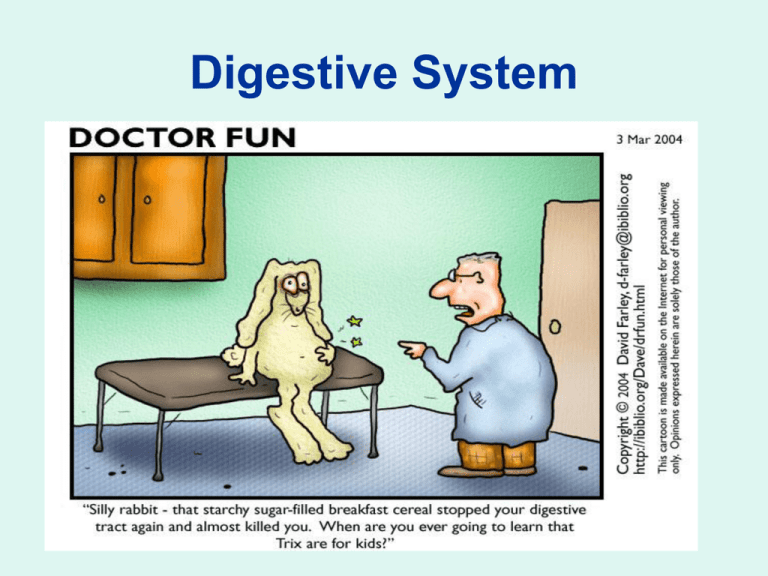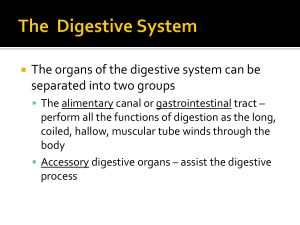Digestive System - Solon City Schools
advertisement

Digestive System Digestive System Structures involved in digestive system • The digestive system of mammals consists of the following: -(mouth, oral cavity, pharynx, esophagus, stomach, small intestine, large intestine, rectum, anus) -also includes other associated structures/organs/glands (salivary glands, gall bladder, liver, pancreas). Function of Digestive System • Digestion is the process of breaking down food into molecules small enough for the body to absorb. Oral Cavity • hard palate: has ridges; separates the oral cavity from the nasal cavities • soft palate: soft because there is no bone underneath (nasopharynx lies above it) • pharynx: (throat) common passageway for digestive and respiratory system • esophagus: tube connecting oral cavity to stomach. • glottis: the opening to the larynx (a.k.a. voicebox which leads to trachea/windpipe) • epiglottis: the flap that covers the glottis during swallowing Oral Cavity Diagram uvula Oral Cavity • Purpose of teeth is to grind food & increase the surface area. • Papillae (tiny bumps) on the tongue contain taste buds. • Like all young mammals, fetal pigs have milk teeth (baby teeth) that are later replaced by permanent teeth. Oral Cavity • Salivary glands produce large amounts of saliva (>1 l/day in humans). • Saliva contains: • water for moistening food • Mucus for lubricating food and binding it into a bolus (ball of mush) • salivary amylase to start the breakdown of starch How is food swallowed? • Food moves to the pharynx, (throat) which in humans, leads to both the trachea and the esophagus. • While food is being swallowed, the epiglottis blocks the trachea and the uvula blocks off the nose. • Then food reaches the esophagus,(tube that connects the pharynx to the stomach) (throat) uvula Oral Cavity of Pig Stomach • The stomach has several muscle layers surround the stomach, serving to churn food. • The stomach can expand to hold about 2 L of food (= 1/2 gal). It contains acid to digest food (ph = 2) and enzymes to breakdown protein. Stomach diagram Sphincters • The cardiac sphincter closes off the top end of the stomach and the pyloric sphincter closes off the bottom Small Intestine and accessory organs • • • Small intestine has a length of about 6 m. A lot of digestion happens here. S. int. secretes enzymes and pancreas/gall bladder dump enzymes into duodenum to continue digestion. Liver- The largest internal organ of the body. Makes bile, which aids in the digestion of fat. Detoxifies poisons like alcohol. Stores extra glucose in the form of glycogen. Gall Bladder- Sack on the bottom of one of the liver lobes. Stores bile until it is ready to move into the duodenum. Pancreas- Makes digestive enzymes that are dumped into duodenum of the small intestine. Makes the hormone, insulin, which regulates the amount of sugar in the blood. Small Intestine • SECTIONS OF THE SMALL INSTESTINE • Duodenum- The first part of the small intestine which has ducts (tubes) leading into it from the liver/gall bladder and pancreas. Bile and pancreatic enzymes are mixed with food here. • Jejuno-ileum- All the small intestine except for the duodenum. Digestion of food is completed here and nutrients are absorbed through its walls into the blood stream. • Caecum-a pouch off the digestive tract between the small intestine and the colon. Produces enzymes that digest cellulose. (is the appendix in humans) Lower digestive tract of the pig Lower digestive tract of pig Large Intestine • The large intestine or colon functions to re-absorb water. • Bacteria live here like Escherichia coli (E. coli) which produce gases as they ferment their food. • Occasionally, some of this gas is released. As these bacteria digest/ferment left-over food, they secrete beneficial chemicals such as vitamin K, Vitamin B, and some amino acids, and are our main source of some of these nutrients. Sections of Large Intestine • • Spiral colon-spiraled part of the large intestine. Absorbs water, vitamins, and minerals from the food and moves them into the bloodstream. Descending colon- The part of the large intestine leading from the spiral colon down to the rectum. Same function as the spiral colon. Large Intestine Diagram Rectum • The rectum is the end of the large intestine and functions for storage of the feces, the wastes of the digestive tract, until these are eliminated. • The external opening at the end of the rectum is called the anus. The anus has two sphincters, one voluntary and one involuntary. The pressure of the feces on the involuntary sphincter causes the urge to defecate and the voluntary sphincter controls whether a person defecates or not. Rectum of digestive tract of the pig








